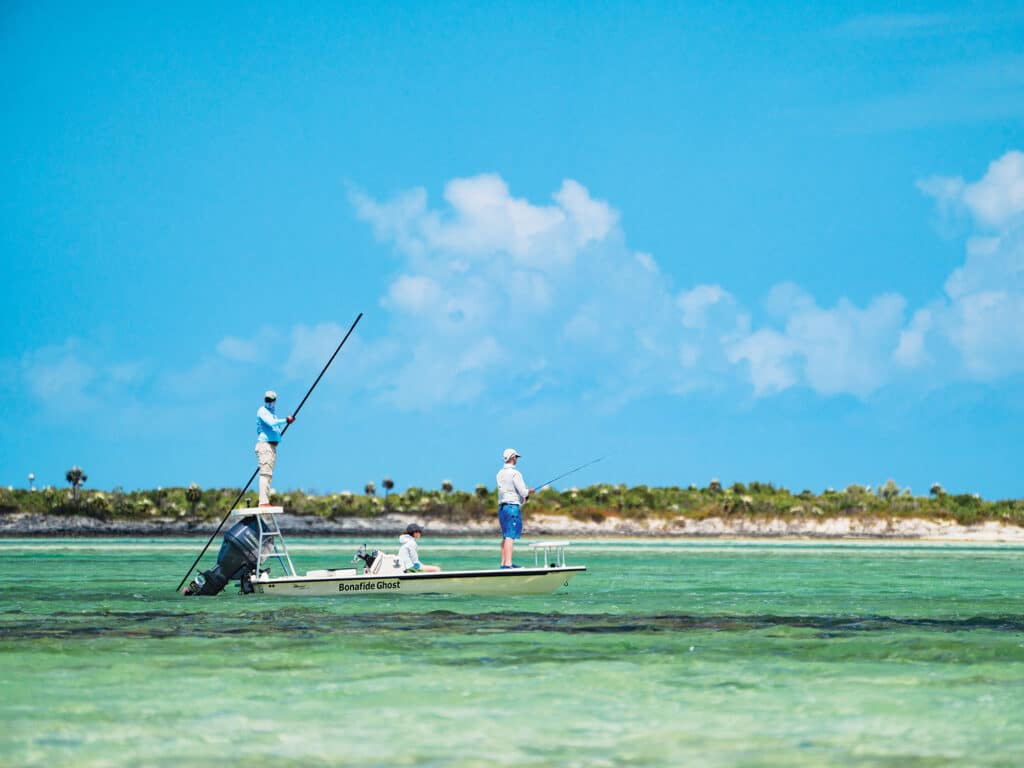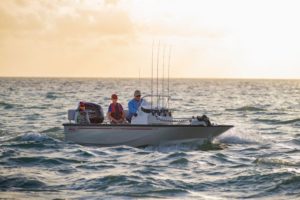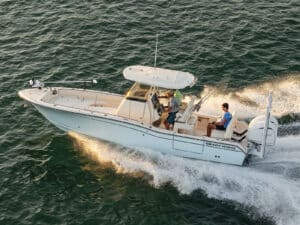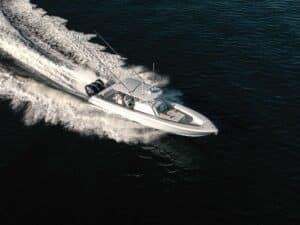
Capt. Rich Smith is a South Florida native, born and raised on the water. These days he guides full time from Miami to Key West, taking about 300 trips each year. He spends most of his time fishing the productive flats of Duck Key, but he will trailer his boats to wherever the fish are biting. After a lifetime of messing around on boats, he’s gotten pretty picky about what he wants in a flats skiff. Here are some of his must-haves, though he also recommends that you take a look at what the guides around you are using.
A Dry Ride
“I used to have boats that were so wet that I’d joke we should dump a bucket of water on us before we left the dock just to get it over with. But that gets old fast, and I’d rather not drench my clients, so I want a boat with a dry ride. Look for a boat with oversize spray rails along the front that will knock down any splash—the bigger the better.”
A Smooth Ride
“I choose boats with a V-hull because I often have to cross open water. I like a boat with a sharp entry to cut the chop and the waves, combined with a small-V deadrise to soften the impact. Twelve degrees is what many premium flats-skiff builders go with, though there are models with 13. For those who want to get really skinny, look at some of the skiffs with only 2 degrees of deadrise in the back. Despite the small V-bottom on my boat, I can still get into 6 inches of water. The oversize splash rails keep it dry.”
On Platforms
“Species like redfish aren’t the brightest, so a really tall platform is OK if that’s what you primarily target. However, species like bonefish, permit and tarpon are very spooky, especially in the crystal-clear waters of the Florida Keys. A smaller platform works better for these picky species.
“You should also check the clearance of the platform to ensure that it doesn’t touch the engine’s cowling. Turn the engine all the way to each side to make sure it doesn’t rub. Also, raise the motor all the way up to make sure it doesn’t hit on top. I had a flats boat with a jack plate that would rub and make some nasty marks on the cowling if it were raised up all the way. To those who don’t know, engine cowlings are very expensive—and very expensive to get repaired. One small gash the size of a fist I put on an outboard was about $1,200 to repair.
“Bow casting platforms are a nice touch, but you need a developed set of sea legs to make use of them. Consider your (and your friends’) abilities before you get a raised bow casting platform.”
On Push Poles
“I want the longest push pole I can get away with. I go with the longest pole that Stiffy makes, a 24-footer, for all the open-water flats days, and for the days I’m going to be way up in the creeks of the Everglades, I have a 21-footer that is easier to maneuver through the tighter confines. Just note that while the 24-footer is great for an 18-foot skiff, it might be a little much for a 16-foot boat.”
Trolling Motors
“Trolling motors are a big plus if you plan on working shorelines like I do. You can effectively cover lots of ground. Twelve-volt models can suffice if you’re on a budget, but if you’re going to be fishing creeks that have current, you will want a 24-volt system. And if you have a large, heavy boat like a 21-foot skiff, you’ll want to opt for a 36-volt model.
“Just keep in mind when you start loading down the skiff with several batteries and a heavy trolling motor that you will sacrifice some of the boat’s draft. Newer, lightweight high-tech lithium-ion batteries are great for saving on weight, but they do come with a heavy price tag.”
Weight Distribution
“When you get into the world of ultra-light carbon-fiber skiffs, every pound counts. Most run better if you put the batteries in the front hatch, along with the fuel tank. But I have had skiffs that run better with the batteries in the console or farther back in the boat. Talk to someone with a similar boat, or experiment with yours until you get it right.”
For more about Capt. Smith, check out his website.









